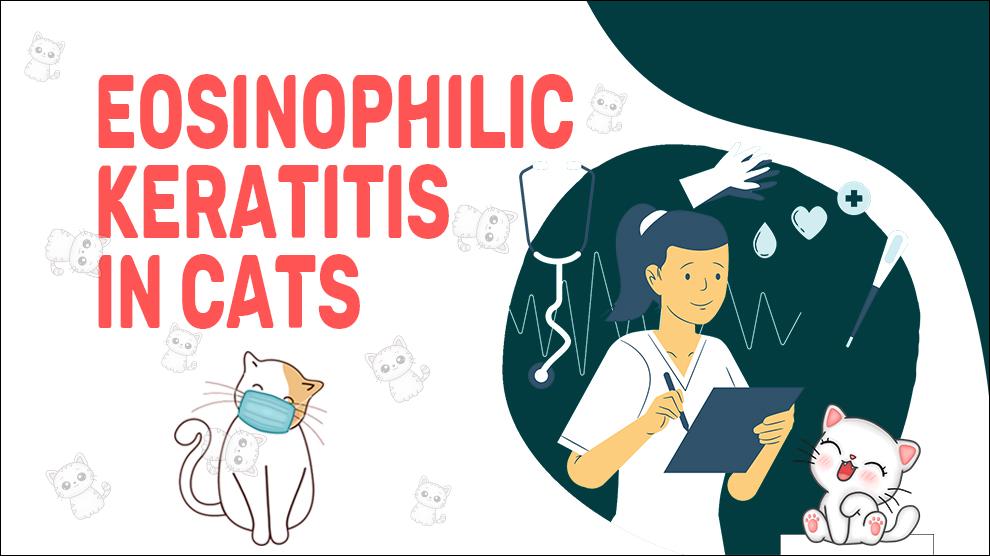What Is Eosinophilic Keratitis In Cats?
Eosinophilic keratitis is a condition where the cornea of the eye is infiltrated by eosinophils, a type of white blood cell.
This infiltration can cause a range of symptoms, including eye irritation, inflammation, and vision loss.
The exact cause of the condition is unknown, but it is believed to be related to an immune response to allergens or other irritants.
Treatment typically involves a combination of medications to reduce inflammation and promote healing.
Clinical Signs Of Eosinophilic Keratitis In Cats
The symptoms of eosinophilic keratitis in cats can vary, but they usually affect one or both eyes.
The most common signs of this condition include:
- White, pink, or gray raised masses on the surface of the cornea, which may grow and spread over time
- Redness, inflammation, and swelling of the eye
- Discharge from the eye
- Cloudiness or opaqueness of the cornea
- Sensitivity to light
- Squinting or rubbing of the affected eye
- Lesions On The Cornea
- Pain In Eyes
- Eye Irritation
- Excessive Blinking
- Pawing At Eyes
- Constricted Pupil
- Mucus Discharge In Eyes
- Raised Third Eyelid
Treatment Options For Eosinophilic Keratitis In Cats
The treatment of eosinophilic keratitis typically involves a combination of medications to reduce inflammation and promote healing.
Some common medications used to treat the condition include:
- Topical steroids: These medications are used to reduce inflammation and swelling in the affected eye.
- Cyclosporine: This medication is used to suppress the immune response and reduce the infiltration of eosinophils into the cornea.
- Antibiotics: In cases where the cornea is ulcerated or infected, antibiotics may be prescribed to prevent further damage.
- Anti-inflammatory drugs: These medications can help to reduce pain and discomfort associated with the condition.
Home Remedies For Eosinophilic Keratitis In Cats
While there is no specific home remedy for eosinophilic keratitis, there are some things you can do to help manage your cat's symptoms:
- Keep the eye area clean: Use a damp cloth or cotton ball to gently wipe around the affected eye. This will help to remove any discharge or crust that may have accumulated.
- Apply a warm compress: Soak a clean cloth in warm water and gently press it against the affected eye for a few minutes. This will help to soothe your cat's eye and reduce inflammation.
- Use a saline solution: You can use a saline solution to help flush out any debris or irritants that may be causing your cat's eye to become inflamed. Mix one teaspoon of salt in one cup of warm water and use a dropper to apply the solution to your cat's eye.
- Feed your cat a healthy diet: A healthy diet that is rich in antioxidants and omega-3 fatty acids can help to boost your cat's immune system and reduce inflammation.
How To Prevent Eosinophilic Keratitis In Cats?
As the exact cause of eosinophilic keratitis is unknown, it can be difficult to prevent.
However, keeping your cat's environment clean and free from potential irritants may help to reduce the risk of developing the condition.
Regular veterinary check-ups can also help to identify any underlying health conditions that may increase the risk of developing eosinophilic keratitis.
Affected Cat Breeds Of Eosinophilic Keratitis
Causes For Eosinophilic Keratitis In Cats
Causes:
The exact cause of eosinophilic keratitis in cats is unknown, but it is believed to be an immune-mediated disorder.
This means that the cat's immune system overreacts to an unknown trigger, causing inflammation and the infiltration of eosinophils into the cornea.
Some of the factors that may contribute to the development of this condition include viral or bacterial infections, allergies, or an underlying autoimmune disease.
When To See A Vet For Eosinophilic Keratitis In Cats?
If you notice any of the symptoms of eosinophilic keratitis in your cat, it is important to seek veterinary care as soon as possible.
Prompt treatment can help to prevent further damage to the eye and improve the chances of a successful outcome.
Food Suggestions For Eosinophilic Keratitis In Cats
There are some dietary considerations that may be helpful for cats with eosinophilic keratitis.
Specifically, feeding your cat a diet that is rich in antioxidants and anti-inflammatory nutrients can help to support their immune function and reduce inflammation throughout the body.
Some good options include:
- Foods that are rich in omega-3 fatty acids, such as salmon, sardines, and anchovies.
- Fruits and vegetables that are high in antioxidants, such as blueberries, spinach, and carrots.
- High-quality, grain-free cat foods that are made with whole, natural ingredients.
Conclusion
Eosinophilic keratitis is a relatively rare but serious condition that can cause significant discomfort and vision problems for affected cats.
If you suspect your cat may have eosinophilic keratitis, it is important to seek veterinary care as soon as possible to get an accurate diagnosis and appropriate treatment.
With proper care and management, however, many cats with eosinophilic keratitis can go on to live happy and healthy lives.











